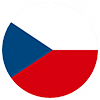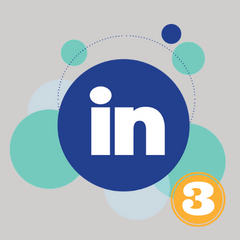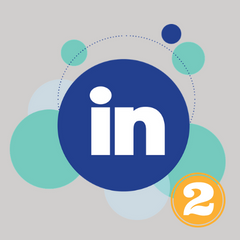Are you receiving job offers on LinkedIn that don't match your wishes? Is your inbox bursting with offers that don't interest you? At first, you replied politely to all recruiters, but eventually, you gave up... We know the reason for these unsuccessful attempts! In this article, we'll show you what to do to get job offers exactly the way you want.
Currently, LinkedIn is one of the most important and sought-after platforms where IT experts receive offers for new projects. It's a place where you can present your experience, skills, and professional profile. And precisely for IT recruiters, constantly updated LinkedIn profiles are a crucial tool for finding suitable candidates to fill various IT positions. You might already guess where we're heading.
Keep your LinkedIn profile up to date
One reason it's essential to keep your LinkedIn profile current is to ensure the relevance of your experience and skills. If your profile contains outdated information about the technologies and platforms you work with, IT recruiters might overlook you. Even if you're perfectly suited for the position and would genuinely enjoy the project. Your profile speaks for you at this point.
If you want to know how to thoroughly complete your LinkedIn profile, read the article "How to Succeed on LinkedIn and Perfectly Fill Out Your Own Profile. Part III.", where we'll show you all the nooks and crannies of LinkedIn, which might surprise you.
Are you interested in the IT field and looking for job positions and opportunities in the IT industry? Whether you are a programmer, developer, tester, analyst, or software architect, contact us and we will find an IT project tailored to your needs from our IT job offers. Take a look at the current available job positions in the IT field. We will help you find new job challenges and opportunities. We look forward to collaborating with you!
Example of an ideally completed LinkedIn profile:
Motto
The motto is visible immediately under your photo, and it is often the first piece of information someone learns about you. Take care with your motto. You may encounter mottos containing quotes or wisdom to live by. However, if you take LinkedIn seriously and want to receive relevant job offers and connections, use your motto differently. In the motto, it's good to state your current position, BUT with precision. If you write "SW Engineer" or "Tester" into the motto, the recruiter won't learn much about you at first glance. Try to include the development language you use or the form of testing that is your bread and butter in the motto. It should be clear at first glance what you REALLY do.
Summary
You can elaborate more in the Summary. It's longer, so you have more space to write not only what you do and what you enjoy but also what you're looking for. In a few sentences, describe what you do most of your working days and the position where you have the most experience and knowledge. Also, mention the technologies or frameworks you're most familiar with. You'll help the recruiter understand you better and offer you a project that will truly suit you.
When it comes to technologies, we have a small recommendation. Consider which ones are really important to you and list a maximum of 3-4. This will showcase your professionalism. If you list all the ones you've ever encountered in your life, you'll take the recruiter back to the start, and they will again be uncertain whether the project will be exactly right for you. Sometimes less is more.
For example, if you are a manual tester and would like to move into automation, this is exactly the place to write it. Feel free to use phrases like: "I would like to move into automation in the future and broaden my horizons in XY area."
The summary gives you 2,000 characters, just remember that if someone doesn't click directly on the Show more button, they'll only see the first 3 lines.
Work experience
Job titles are great, but not everyone can imagine what was part of your job responsibilities and with which technologies you worked based only on the title. So let's try to do it differently and better. Write a few sentences for each position (or feel free to use bullet points if you don't want to write lengthy sentences :). Describe the content of the job and add the most important technologies. Here again, we recommend selecting only the most important ones, so as not to confuse recruiters. Don't be afraid to write more about the position you are currently doing and is therefore the most current. Details create the overall impression. The description should contain information about what technologies and in what context you used them.
For example, if you worked as a web developer, you could mention that you specialized in web application development and mainly used technologies such as HTML, CSS, JavaScript, and frameworks like Angular or React. You could also mention if you worked with backend technologies like Node.js, Ruby on Rails, or PHP etc. If you worked as software engineers, you could mention that you worked on developing desktop applications and mainly used programming languages like Java, C++, or C#. You could also mention what frameworks or tools you used in development, like .NET Framework.
Skills
Your skills are a very important part of the profile that recruiters look at. To keep this section up to date, we have a little trick for you. Arrange your skills using the Arrange option so that your primary technologies are at the top. This way, you can list all the skills you have, but the recruiter will first see the ones you are currently working with and won't prepare offers for you with skills that you no longer want to brush up. The second option is to delete outdated skills.
How Many Technologies to List?
We've mentioned this information several times in previous paragraphs, but it's so important for us that we've decided to write about it separately. List only the main technologies you work with. In the field of IT, there is a very wide range of programming languages, frameworks, and tools. However, if you list too many technologies on your profile that you've encountered in the past but do not actively work with, IT recruiters may get lost in the quantity and it won't be clear to them what your expertise is. It is therefore better to focus on the main technologies that you have worked with and in which you truly have expertise. In this way, you also show that you really understand the technologies in question.
Not Currently Looking for a Job?
Do you have a job that you're satisfied with and don't want to constantly receive offers that you have to reject? With the following tips, you'll avoid having to send rejection messages. We recommend this article where we describe this situation in great detail: How to Succeed on LinkedIn and How to Perfectly Complete Your Own Profile. Part III.
How to Communicate with Recruiters to Get What You Want?
The basis is good feedback that prevents you from receiving offers you don't like. If you get an offer from a recruiter, communicate with them - ideally politely, and you'll see your effort returned soon. Don't forget to say hello and let the recruiter know whether or not their offer hit the mark. If the offer was completely out of line with your expectations, don't hesitate to write what kind of position with specific details you would like and whether the recruiter can contact you in the future. When recruiters come across something that would be perfect for you, they will get in touch. And if you like the offer, don't hesitate to ask for details that interest you. Ask about everything! Even if you receive offers often, don't look at them as SPAM, thanks to them you have an overview of the market and know what you can afford or where you might move in the future. If you trust a recruiter, feel free to add them to your connections. You will both appreciate it in the future.
Maintaining an up-to-date LinkedIn profile with relevant information about your experiences, your favorite technologies, and brief descriptions of each position, can increase your chance to be seen and approached by IT recruiters with the right offer. It's a great way to present yourself and gain new professional opportunities. Don't forget to regularly update your profile and tailor it to your career path and goals.
🟡 Are you looking for an interesting project? Check out how we do things here and see which colleagues we're currently looking for.
🟡 Do you have a colleague or friend who is looking for a new project? Join our Referral program and get a financial reward for your recommendation.
🟡 Would you like to start working in IT? Download our ebook START WORKING IN IT: From First Steps to Dream Job, in which we guide you step by step with information, courses, and practical experience that are so essential not only for those who want to switch fields, but also for those who want to advance their careers and further their education.
Or share this article, which may also be useful to your acquaintances.














